Ficus elastica
Have you ever seen a plant that was so incredible that you had to touch it to convince yourself that it wasn’t artificial?
That’s the rubber tree.
Its gorgeous, uniformly large, waxy leaves and amazing colors – variegated green and white, burgundy, nearly black – will beckon you to touch them.
They’ll feel as though they were molded by hand of a material that you can’t quite name.

We link to vendors to help you find relevant products. If you buy from one of our links, we may earn a commission.
You’ll be shocked to learn that it’s a real, living plant, and even more astounded as you discover more about its growth habits and historical uses.
Rubber tree is in the Moraceae family, and belongs to the Ficus genus, also known as the fig-bearers.
Ficus plants of various types are grown all over the world, and it’s not difficult to tell why. Somehow, they manage to be beautiful, tough, and graceful, all at the same time.
This plant has been known as a symbol of good luck and good fortune; will it be lucky for you? Get ready to learn all about the rubber tree!
What You’ll Learn
Cultivation and History
In the tropical forests between India and Indonesia, the rubber tree grows wild.
Sometimes called rubber fig or rubber bush, in its native environment, this tree can grow over 100 feet tall, branching and sprawling through the forest freely, creating shelter for animals and humans alike.

Historically, rubber trees have served two important purposes to the people in the region.
The latex, or milky sap, that bleeds from the bark when punctured, was once tapped and processed to make rubber.
This type of rubber is now obsolete, replaced by that of the Amazonian rubber tree, H. brasiliensis, which is easier to tap and produces more sap.
Rubber tree sap will readily spill if the bark is damaged or if limbs or leaves are broken, and should be handled with caution.
Not only can it irritate skin, it can be toxic to house pets such as cats and dogs as well, and stains nearly anything it comes in contact with.
The second most historically common purpose for the rubber tree was its use as a material for living bridges.
These astounding bridges were created by training the roots of the trees to grow along fallen logs that were placed across ravines and rivers.

Roots of the plant are extraordinarily tough and highly flexible, so these bridges sometimes survived for hundreds of years.
While it’s amazing that tree roots can form such structures, this also acts as a warning.
Rubber tree is also known as a banyan plant, a part of the epiphyte or strangler fig family. When given ideal growing conditions, this plant can overtake an area with buttressed roots that spread for hundreds of feet in some instances.
Roots can even grow aerially, reaching between trees.
Because the roots are so prolific, they can quickly become overgrown and “strangle” other plants, including large trees.
Some specimens of banyan figs have been known to grow so large that they were used as makeshift temples for religious ceremonies in their native region.
With shade loving tendencies, low maintenance requirements, and easy propagation, it’s not hard to see why rubber trees are popular houseplants.
This cousin to the beloved fiddle-leaf fig is commonly chosen as a part of modern decor for its structured growth habit and eye-catching focal interest.
As an evergreen tropical, it can add a living dimension to your home year-round.
Propagation
Typically, it’s absurdly easy to propagate a healthy rubber tree.
As previously mentioned, this plant is such a prolific grower that it sometimes only needs to be pruned and repotted, rooting at will.

It’s best to start with a young plant to allow it to acclimate to the environment inside your home.
Prior to handling cuttings or piercing the bark of the tree, be sure to pull on a set of gloves to protect your skin and prevent contact with the sap, as it’s a known irritant for some people.
Make sure any tools you’ll be using, such as a knife or shears, are sharp and clean to prevent spreading disease or damaging the plant.
You’ll likely want to have a rag on hand to collect the latex sap, and bringing the plant outdoors or placing it on a protective surface like a potting mat or tarp can protect furniture and work surfaces from stains.

You can find a nice selection of potting mats on Amazon.
From Cuttings
If you happen to know someone who has a rubber tree in their home, you could ask them for a clipping the next time they prune the plant back.
The best time of year to take cuttings is late spring or early summer, when the plant is actively growing.
A pruned branch need only be about six inches long, however, be sure the cutting has at least three to four leaf nodes for best results.
Nodes are the places along the stems of the plant where leaves grow, but when these are covered with soil, they will root instead.
There are two ways to handle the cutting to propagate a new plant.
The first method is to simply dip the open end of the cutting in a powdered rooting hormone and place it in water.
Sit the cutting near a sunny window, out of direct sunlight, and give it time to root.
This method is moderately successful for most people, but the second method is practically foolproof.
Strip all but one leaf off of the cutting, being careful to avoid touching the sap, as it will ooze from each leaf node.
While you wait for the sap to stop discharging, prepare a 6- to 8-inch pot with one part each of potting soil, sand, and peat moss, and moisten throughout.
Press the cutting into the soil loosely, no more than one to two inches deep, and wrap the cutting and the pot with a clear plastic bag.
Place the cutting in a sunny place, but out of direct sunlight, and maintain humidity. An ideal location would be near a bathroom window, unless you’ve got access to a greenhouse.
Cuttings may take anywhere between three to six weeks to root.
Once the roots have begun to sprout and you observe buds forming at the nodes, you can transplant the cutting to a new 10- to 12-inch pot with a blend of one part each potting soil and peat moss or coconut coir.
Seat the rooted cutting so the top of the roots sit just below rim level. This will allow for aeration and helps to prevent smothering.
Be sure that the pot you choose has adequate drainage; clay pots work best for rubber trees to allow for transpiration.
Place the pot in a location with diffused or indirect sunlight and water thoroughly.
Air Layering
One of the least challenging methods of propagating a rubber tree is by air layering.
This process takes a little time, but it produces a plant with a stronger root system, grown while it is still attached to the parent.
To begin, choose a healthy branch that is 10 to 12 inches in length with at least a few leaves present.
Locate a place between two leaf nodes where you plan to detach the new plant from the parent after the roots have formed.
On this part of the branch, use a sharp knife to cut just the bark away between the nodes, cutting all the way around the perimeter of the branch.
After this section of bark is removed, wait for the sap to stop bleeding. Dust the exposed xylem with rooting hormone powder.
For the next step, use a handful of sphagnum moss or coconut coir and wet it until it is damp. If you’re using moss, you can wrap it around the open wound on the branch.
After wrapping the branch, you can use a piece of plastic such as cling wrap or a plastic bag to tie around the moss, sealing in the moisture.
Both ends can be closed using twist ties so you can easily access the moss to check for dampness and watch for root growth.
If you’re using coconut coir, spread the plastic on a flat surface, place the coir on the plastic, and wrap the branch as previously described.
Be sure to close the ends securely so none of the medium falls out.
Open the plastic every few days and check that the medium feels damp. If it feels dry, you can squirt a few eyedroppers full of water onto the medium to moisten it, and then close the plastic back up.
Typically, it can take two to four weeks for roots to develop using this method. Once a small root ball has formed, use a sharp knife or pruning shears to cut the branch free from the parent.
Prepare a 12- to 18-inch pot that has good drainage with one part each of potting soil and peat moss or coconut coir, and pot the entire root ball of the plant to just below the rim, watering thoroughly to settle.
Press the soil around the base of the trunk to secure.
Place your new plant in a sunny location but away from direct sunlight.
How to Grow
Rubber tree is a low maintenance, robust plant that can survive quite a bit of neglect. Its large, waxy leaves retain water well, and in the winter months when the plant is dormant, it needs little water.
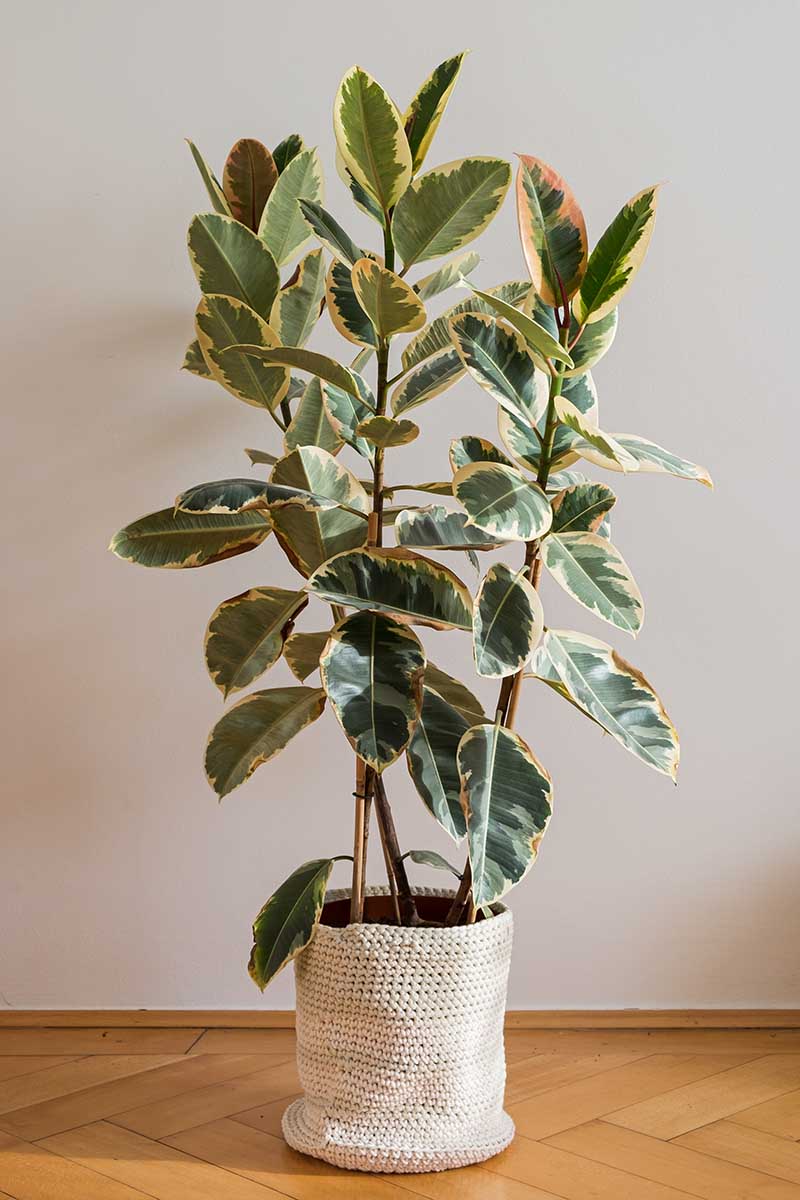
The spring and summer months are when the most growth will happen, and the plant will need more water, along with more sunlight.
Avoid placing it in direct sunlight. However, if you notice that the leaves are wilting or discolored, or if the plant appears leggy, more sun may correct the issue.
Be sure that you do not overwater your rubber tree. Too much water can lead to root rot, dropping or drooping leaves, and poor growth.
A liquid fertilizer for tropical plants can be added in spring or summer if needed, according to package directions.
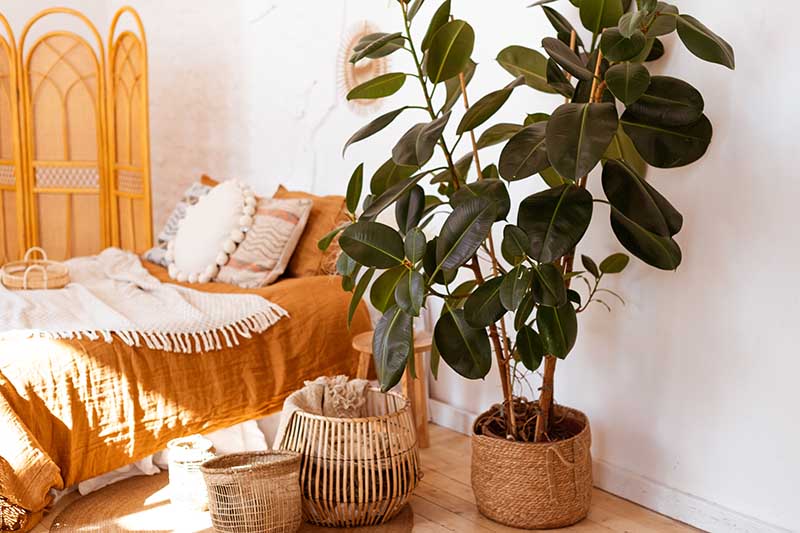
As your tree grows, check to make sure the roots are not overtaking their container.
Roots that are growing at the soil surface may branch and curl to the edge of the pot in a process known as girdling, and you may notice some discoloration of foliage or leaf drop.
If the pot has large drainage holes, you may be able to see visible roots that have become compacted there as well.
One way to check for proper spacing is to remove the plant from the pot and observe whether the roots have become bound, or tightly constricted, in the form of the pot.
If the roots seem to be taking up most of the available space, it’s time to repot.
Choose a container that is one to two inches larger than the previous pot.
Add a layer of the same soil and moss or coir mixture at the bottom, leaving space for the root system of the plant so the top of the roots will be positioned near the level of the rim.
Use your fingers to gently press downward on the girdled roots from the bottom up, so they separate a bit.
As you do this, if you observe any dead or decaying roots, trim them away.
Place the plant in the new pot, and fill in the edges with soil. Water well to settle.
It’s a good idea to repot the plant every few years whether the roots have become bound or not, as adding new potting medium will help to keep the plant nourished and healthy.
At the very least, the top couple of inches of soil can be removed and replaced with new soil or compost, to add nutrients to the pot once every one to two years.
Because the leaves of this tree are so large, they play an important part in maintaining moisture levels.
Increasing humidity to mimic the native tropical environment that these trees originated from can improve plant health.
To do this, mist the leaves a couple of times per month, especially in the winter when indoor heating can create dry air.
Since misting can be messy, you may opt to wipe the leaves with a damp cloth instead. This added moisture can keep leaves healthy and glossy, and maintain moisture levels.
This is also a good opportunity to remove dust that has collected on leaves, and prune away any dead or dying foliage.

Container-grown rubber trees can be moved outdoors if outside temperatures are consistently above 50°F.
Be sure to place the tree in a protected place, and again, shield it from direct sunlight.
Rubber trees can also be grown outdoors in USDA Hardiness Zones 9-11 year round.
Bear in mind, if you’re planning to plant directly in the ground in these zones, the tree may experience rapid growth.
It’s important to keep that growth contained so it doesn’t become invasive and interfere with native vegetation and local ecosystems.
Some outdoor specimens in sub-tropical and tropical climates can grow more than two feet per year, and have been measured at over 100 feet in height, with a sprawling habit.
They can also overtake other adjacent plants.
Plant the tree in an area where it receives indirect sunlight and adequate water, with good drainage. Avoid planting rubber trees near sidewalks or foundations, as their strong roots can damage both.
Growing Tips
- Pot rubber trees in a mix of potting soil, coconut coir, and peat moss for good aeration.
- Do not overwater in dormant months.
- Avoid allowing roots to sit in water as this can cause root rot and wilting.
- Keep near a sunny window but out of direct sunlight.
- Prune new growth as needed to maintain size and shape, and repot as necessary to prevent root binding.
Pruning and Maintenance
Controlling growth is important for a rubber tree, whether growing indoors or outdoors, as these can become large and dense in ideal growing conditions.
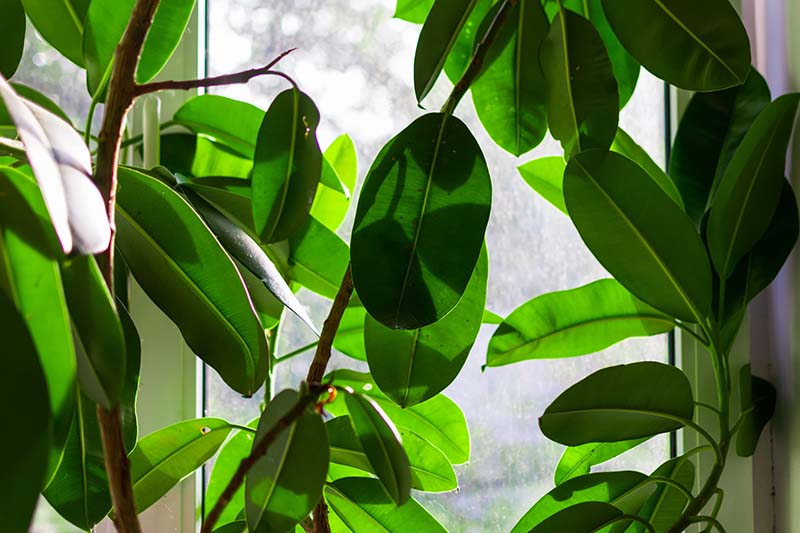
During the spring and summer, these trees can grow as much as 24 inches, so pruning to maintain their shape and size is necessary.
Prune back any limbs that are reaching beyond the desired size and shape of the tree.
Bear in mind that cutting the top of the tree will trigger outward growth, so only do this if the height is becoming an issue, and be sure to monitor unwanted branching and sprawling out.
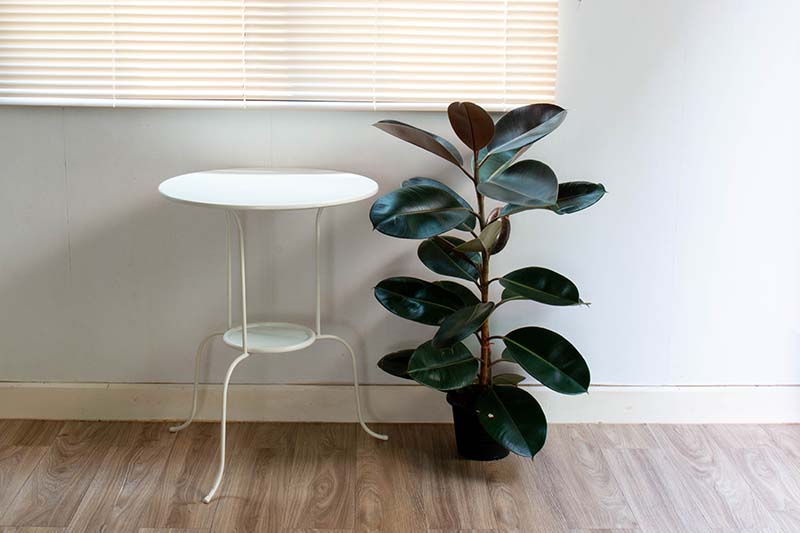
Any time you plan to puncture the bark of the rubber tree, be sure to have a rag handy to control the sap that bleeds out, especially if yours is growing indoors as a houseplant.
The sap is thick and sticky, and it can stain skin, clothing, floors – pretty much anything it comes into contact with. You may want to move the plant outdoors or spread a tarp under it before you begin.
Again, it’s also a good idea to wear gloves, and have a container handy that you can place the cuttings in, such as a trash bag or plastic tote.
Cuttings may continue to bleed sap, and the latex they contain may irritate skin.
Use a sharp tool, such as clean pruning shears or a garden knife, and cut just enough of the branch to maintain its shape and size. Cutting more than is necessary can cause shock and trigger leaf drop, or even kill the plant.
After pruning, continue to observe the plant for several minutes, as it can take some time for the sap to stop flowing, and clean up as needed.
Cultivars to Select
There are a number of stunningly unique varieties of rubber tree to choose from, any of which are suitable for container growing indoors.
Burgundy
This cultivar offers a true “wow” factor.
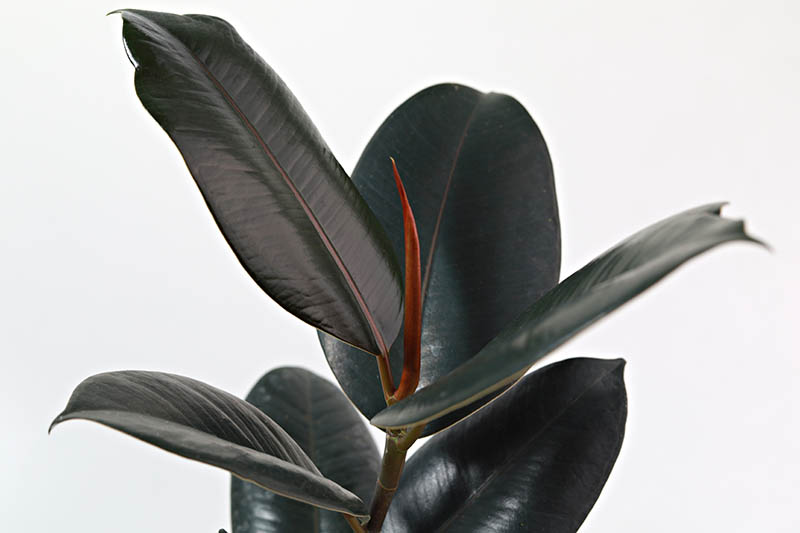
As plants of the ‘Burgundy’ variety mature, their leaves, branches, and trunks range from the deepest green and burgundy to almost black, sometimes with red midribs and scarlet-sheathed new growth.
Decora
‘Decora’ was first introduced in the 1950s. Its form and coloration are most commonly replicated in artificial rubber tree plants, with green and white variegated leaves shot through with red midribs.
Doescheri
‘Doescheri’ is another variegated variety.
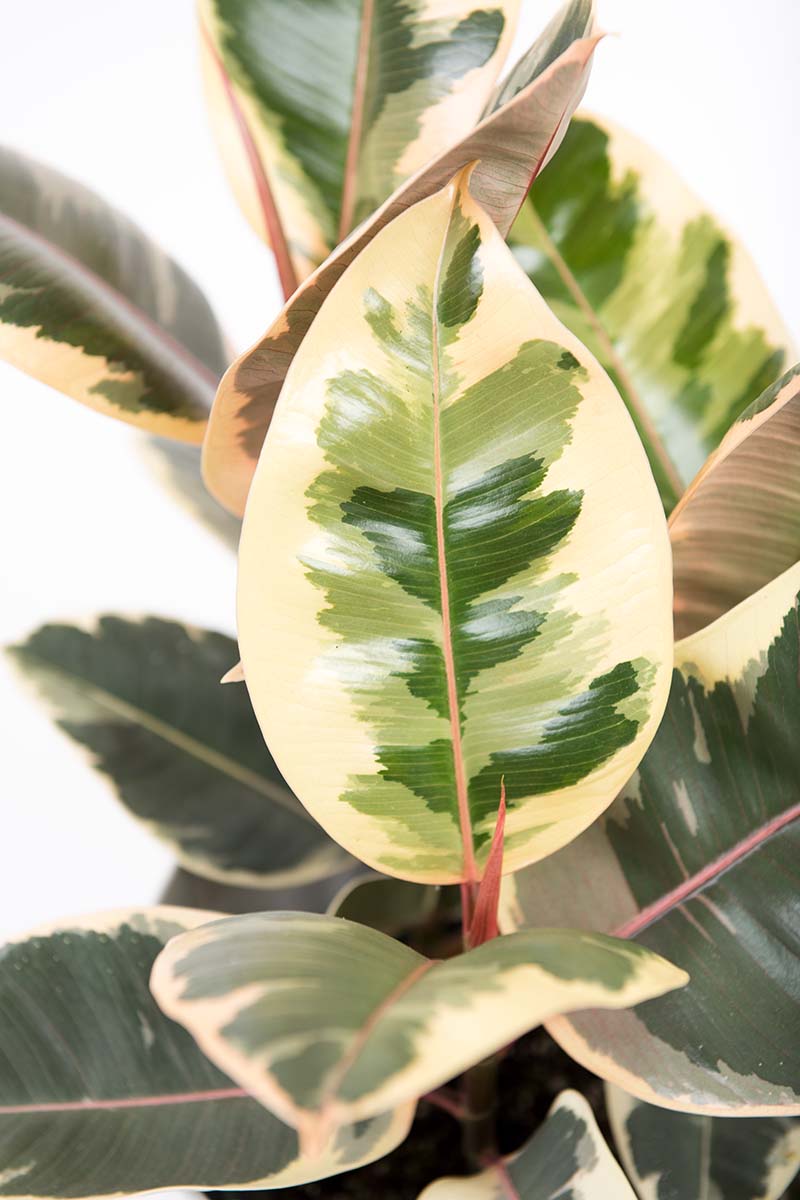
It has leaves that feature shades of creamy white, bright green, army gray, and yellow, mottled together with stunning pink margins.
Robusta
This variety is most closely related to the true species plant that grows natively in Asia and Indonesia.
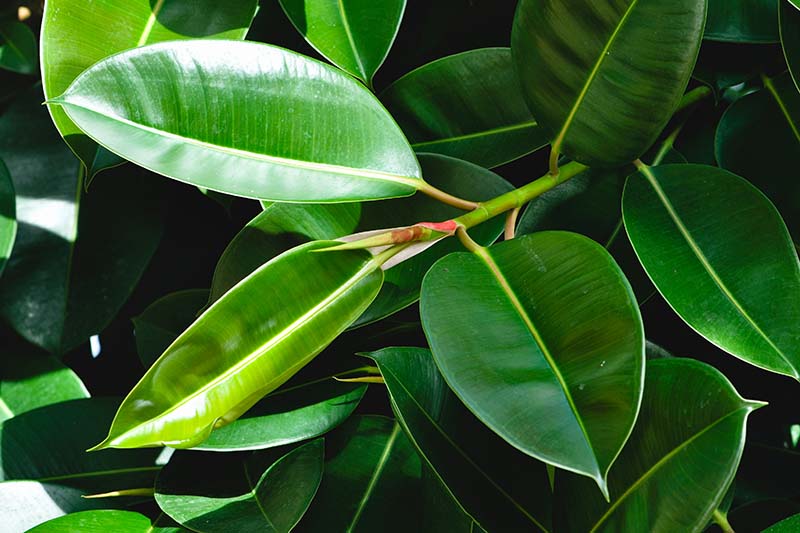
The leaves are waxy, wide, and bright green to deep green in color. The structure and color of this cultivar is perfect for adding a tropical touch to the home.
Ruby
Similar in structure to other cultivars, ‘Ruby’ is set apart by its unique coloration. The leaves are oblong and glossy, with a deep green to burgundy upper side, and a pink to deep burgundy lower side.

The branches and trunk of this variety can be a shocking bright green, maturing to a deeper green or brown. New growth is sheathed in bright scarlet red.
Plants are available from Amazon.
Tineke
Another variegated cultivar, ‘Tineke’ is similar to other variegated rubber trees, with pink to burgundy midribs, sprouts, and leaf margins.
Plants are available from Perfect Plants Nursery.
Tricolor
Young plants of the ‘Tricolor’ variety have variegated cream and white leaves with splotches of pink to orange.
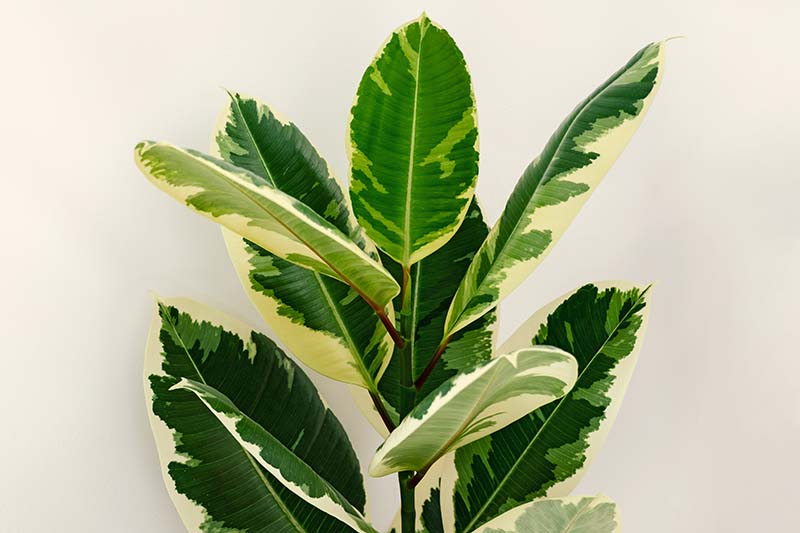
As this plant matures, the coloration leans more toward green and cream, with wide, glossy leaves.
Managing Pests and Disease
Even the healthiest, most robust plants can fall victim to infestation and disease from time to time.
Fortunately, these conditions are relatively uncommon in rubber trees, and can usually be treated easily if they do occur.
Insects
Growing plants indoors reduces or eliminates the threat of damage from foraging animals – with the exception of the adventurous, whiskered house pet.
However, indoor plants can be susceptible to pests and disease.
A healthy rubber tree is resistant to infestation, but be mindful and keep an eye out for signs that you have unwelcome guests.
Aphids
While aphids are fairly uncommon on a houseplant, it’s not impossible for them to find their way in, especially if you have an indoor-outdoor rubber tree that can pick up pests while outside.
Aphids are one of the most annoying pests for any plant owner because they are indiscriminate, puncturing leaves and sucking sap in surprisingly large amounts until plants have wilted and become stunted.
There are many species of aphid, and they can range in color from bright yellow to pale green, and even white.
Their bodies are tiny and pear-shaped, with long legs and antennae. Signs of infestation can look like droopy, wilted leaves, spots, or discoloration.
Once you notice their presence, it’s a sure bet that they’ve likely already laid eggs somewhere on your plant.
Fortunately, rubber tree leaves don’t provide many hiding places with their broad, flat surfaces, and dealing with an infestation should be easier than managing one on, say, your roses or camellias.
To combat aphids, spray the plant with insecticidal soap, or saturate a rag with it and wipe each leaf from stem to tip, top and bottom. Check the stems and trunks carefully, and reapply as needed until signs of infestation are gone.
Find more information about controlling aphids here.
Mealybugs
White, powdery looking webs appear at the junction of leaves and stems when mealybugs are present.
They’re fairly obvious against the dark coloration of most rubber trees, and with regular observation, you should be able to catch sight of webs early on.
Another sign that can indicate a mealybug infestation is spots appearing on leaves, and discoloration as well, as these insects pierce the leaves to access and feed on the sap.
The insects themselves are powdery white in appearance, with ridges along their bodies and a fringe on either side.
They typically measure less than a quarter of an inch in length, and most frequently hide under leaves or along the midribs near the stem.
To rid the plant of mealybugs, apply rubbing alcohol to a cotton ball and rub it over the insects. Be sure to clear away the webs and check leaves carefully for any remaining signs of infestation.
After killing the adults and clearing the webs, use an insecticidal spray that is safe for home use or spray with neem oil every two to three weeks as needed.
Read more about fighting a mealybug infestation here.
Nematodes
You may be surprised to see nematodes on a list of pests because you’ve heard that certain varieties of nematodes are beneficial to the garden.
Some gardeners swear by adding them to the soil to destroy soil-dwelling nuisance insects and improve soil quality.
While this is true in many cases, some types of nematodes are harmful and can kill plants. Aphelenchoides besseyi, commonly known as foliar nematodes, may harm rubber trees.
Parasitic nematodes are microscopic roundworms that find their way into plant leaves, where they feed until the foliage begins to turn yellow and brown.
Fortunately, this type of infestation is rare. But once an infestation is noticeable, it’s typically too late to save the plant, and there is no known treatment for foliar nematodes.
Scale
Scale bugs are insects that infest the leaves of many types of plants. There are many species of scale insects, all of which are semi-flat and vary in color from pale yellow to almost black, with a round or oval shape.
Unlike other insects, adult female scale bugs have no legs and resemble tiny armored leeches. When gathered in colonies, they look a bit like fish scales – hence, the name scale insects.
In spring and summer, they nest in cottony looking cocoons that are fairly obvious when seen on the underside of leaves. One female can produce hundreds of offspring.
Young scale bugs are referred to as “crawlers.” These do have legs, and can make short work of colonizing a plant.
Adults are mostly immobile, attached at the mouth to plant leaves, sucking the sap. They produce a white, powdery substance on leaves, which can be obvious on rubber plants.
As the infestation worsens, they cause leaves to appear mottled with yellow blotches, sometimes with brown spots as well. Eventually, foliage may begin to droop or fall off, and you may see black sooty mold appearing on the leaf surfaces.
Because scale bugs puncture the plant leaves to access the sap, they can easily spread disease if they are not dealt with quickly. It’s best to treat plants when insects are in the crawler phase if possible. Otherwise, it can be difficult to deal with an infestation.
Spray plants with neem or horticultural oil according to package instructions, being sure to coat the leaves, both top and bottom. The oil is used to suffocate the insects.
One application of oil may not do the trick, and you may need to go back for a second round to thoroughly saturate the leaves, particularly on areas where adults or crawlers are present.
Once the infestation has been treated, carefully observe the plant at least once a week for new evidence of reinfestation. If signs appear, repeat the process as often as necessary.
Pull on a pair of gloves to avoid coming into contact with any sap, and prune back damaged parts carefully.
Discard pruned material in the trash, away from your other plants. Disinfect any tools used in the process to avoid spreading disease.
Read more about identifying and controlling scale insects here.
Spider Mites
Spider mites are arachnids, and they’re nearly microscopic at just 1/50th of an inch in length.
Not only are they difficult to spot, but they gather underneath leaves, so they can go completely unnoticed while sucking the sap from plants. By the time you discover the damage, it can be significant.
During heatwaves or very dry periods, they are more active, with their presence appearing as silver or bronze discoloration, and speckling of a brown or black color on leaves.
A miticide, specifically formulated to treat these pests, will save a lot of trouble and potential loss. Apply according to package instructions, and reapply two more times at seven- to 14-day intervals to treat any emerging offspring.
Once the infestation in under control, wear gloves and prune back dead foliage. Discard plant material in the trash, away from other plants. Disinfect any tools to prevent the spread of disease.
Find more tips on combating spider mite infestations here.
Disease
As previously mentioned, rubber trees are robust, and as such, they’re rarely affected by disease.
Plants grown indoors are unlikely to fall ill; however, it’s still a good idea to watch for signs of one particular condition.
Root Rot
Most plants can be subject to root rot, especially those that require well-drained soil that have been overwatered and become mired. Fungal pathogens can grow in wet soil and cause roots to decay.
Early signs of root rot in rubber trees are yellowing leaves, leaf drop, and wilting. It’s important to catch root rot early; otherwise, it can quickly kill your plant.
Remove the plant from its container and allow the soil to dry out. Clear as much of the infected soil away as possible, bag it, and discard it in the trash.
Trim away infected roots carefully. Dip the remaining root system in fungicide and leave the root system exposed to air for up to one whole day, allowing it to dry thoroughly.
Repot the plant in fresh potting medium, and consider using a terra cotta or clay pot instead of plastic, as this can help to wick away excess moisture and allows for aeration.
Observe for signs of improved health, and after the plant has had a few weeks to recover, feed it with liquid fertilizer according to package instructions.
Find more root rot treatment advice in our comprehensive guide.
Quick Reference Growing Guide
| Plant Type: | Broadleaf evergreen | Foliage Color: | Green, burgundy, pink, white, variegated |
| Native to: | India, Indonesia | Tolerance: | Short periods of full sun |
| Hardiness (USDA Zone): | 9-11 | Soil Type: | Loamy |
| Exposure: | Indirect or filtered sunlight | Soil pH: | 5.5-7.5 |
| Time to Maturity: | 10-15 years | Soil Drainage: | Well-draining |
| Spacing | 6-12 feet (outdoors) | Order: | Rosales |
| Height: | 3-12 feet indoors; 50-100+ feet outdoors | Family: | Moraceae |
| Spread: | 3-6 feet indoors; 50-100 feet outdoors | Genus: | Ficus |
| Common Pests and Disease: | Aphids, foliar nematodes, mealybugs, scale; spider mites; thrips; root rot | Species: | Elastica |
Bring a Tropical Beauty into Your Home
If you want a tropical houseplant that is low maintenance, gorgeous, and tolerant of some neglect, look no further than the rubber tree.
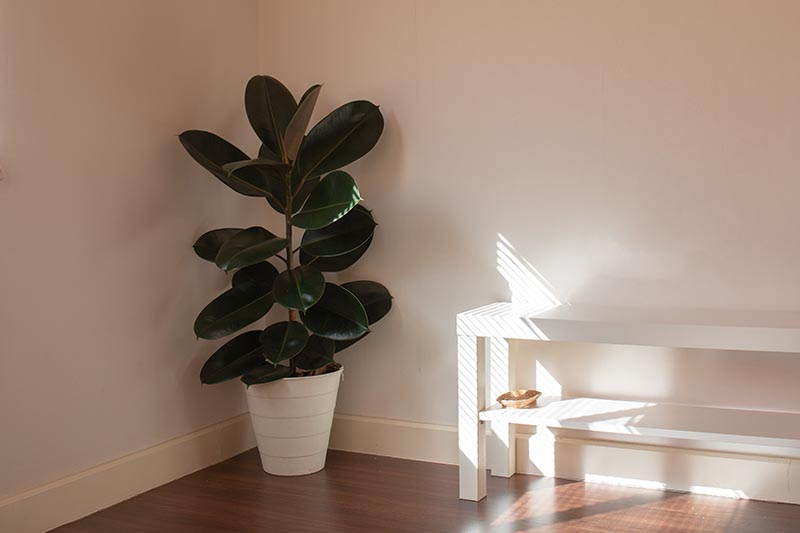
With so many stunning varieties to choose from and very few potential ailments, this plant will grace your home for years with just a little pruning. You can even root the cuttings and share with friends and family.
Let us know what your experience has been with the rubber tree in the comments section below!
Are you interested in learning more about other popular houseplants? Check out these guides next:
- How to Grow Weeping Figs as Houseplants
- Why Is There a Red Sheath on My Ficus Elastica?
- It’s Easy to be Green When You Grow Pothos Houseplants
© Ask the Experts, LLC. ALL RIGHTS RESERVED. See our TOS for more details. Product photos via California Tropicals and Perfect Plants Store. Uncredited photos: Shutterstock.

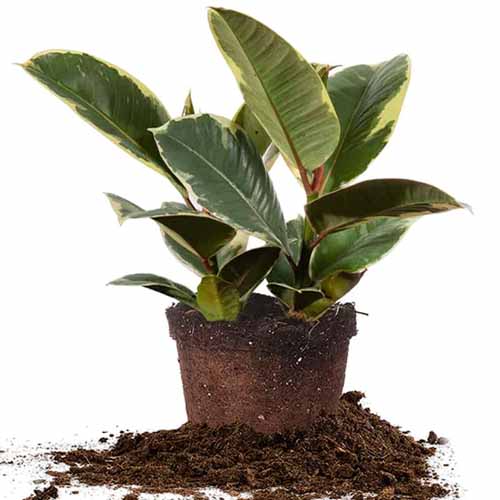

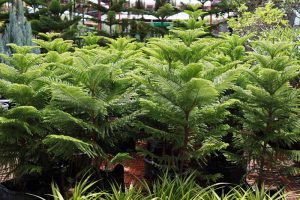
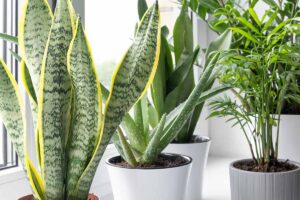
We think our Sandy is about to grow through the roof? What can we do?
Hello Abigail, apologies that I missed your comment! If your plant is healthy, I’d consider pruning her back, or even dividing and rooting her main branches into other pots. Take a look at the section that addresses propagation, and also maintenance, for ideas on how to go about it. Rubber trees that are growing in ideal conditions will continue to grow, so it’s best to prune for size annually to prevent them from becoming behemoths.
Hello, in order to transplant the plant to a larger pot, someone has cut the tap root of my rubber plant – ( it was growing out of the hole in the bottom of the pot.) Will the plant be okay?
Hello Monique, not to worry! If your plant is more than a few months old and otherwise healthy, the taproot is less necessary as it acts as a stabilizer and helps to access water for early growth. Many potted plants benefit from taproot pruning as this allows the root system to branch and develop more fibers, which serve the same purpose. Just keep an eye out for leaf drop or signs of distress, such as yellow or brown leaves or stunting. Otherwise, your plant should be fine!
Why is the suggestion only to put the plant in a slightly bigger pot? I have a small Rubber Tree I’m wanting to grow in a much larger pot? Is the advice to only re-pot up sizes gradually?
Hi Molly! Thanks for your question. You’re correct, it’s best to gradually increase the size of the pot over time. A pot one to three inches larger than the one your plant is in now would be best. This is because the root system must be able to reach nutrients and moisture throughout the soil, and in a pot that’s too large, they’ll struggle to do so. The soil can remain wet for a longer period as it requires more water than the plant needs, which can introduce fungus and diseases that are likely to cause root rot or other… Read more »
Hi.. I recently purchased a beautiful burgundy rubber plant. I love it! However, the leaves seem to have a mineral scale on them that does not wipe off. Any suggestions?
Hi Elle! Burgundy is a gorgeous cultivar!
I’d love to help you figure out what’s going on with your rubber tree. What does the scale look like? Is it spots or does it look like a film? Is there a texture that you can feel?
If you have pictures, please post them so I can take a look.